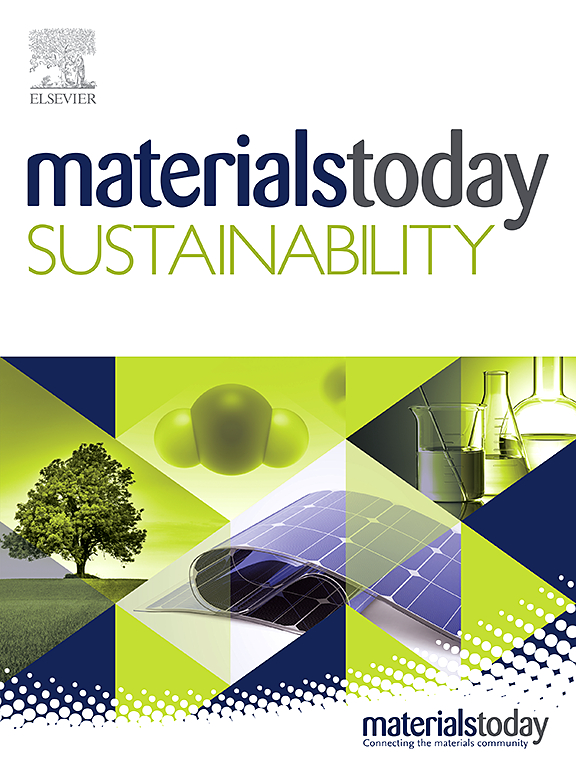Investigation of mechanical behavior and constitutive modeling of silty sand under DWFT cycles
IF 7.9
3区 材料科学
Q1 GREEN & SUSTAINABLE SCIENCE & TECHNOLOGY
引用次数: 0
Abstract
The first phase of the North Xinjiang Water Supply Project is a seasonal water supply project. Owing to the impacts of climate and the environment, the slope of the open channel section of expansive soil has repeatedly experienced sliding damage. After silty sand was used as a replacement material for treatment, the slope still experienced sliding damage after a period of operation. Therefore, this study systematically explored the mechanical properties and physical mechanisms of silty sand under dry-wet-freeze-thaw (DWFT) cycles through direct shear, compression, SEM, electron microscopy, and triaxial tests. The research results show that: (1) As the number of DWFT cycles increases, the cohesion and internal friction angle of silty sand decrease exponentially, with maximum deterioration degrees of 4.61 % and 2.52 %, respectively, while the compression coefficient increases slightly. The influence of cycling on the shear and compression characteristics of silty sand is limited, and it still exhibits low compressibility. (2) Microscopic analysis indicates that the skeleton of silty sand is mainly composed of sand grains, with fine particles and clay mineral aggregates filling the pores. Cycling leads to an increase in internal pores within weakly cemented aggregates and fluctuations in microscopic porosity, but the particle skeleton remains relatively stable. (3) Macro- and micro-scale tests reveal that DWFT cycles have a minor impact on the mechanical properties of silty sand, thus it suffices to study the stress-strain relationship of uncycled samples. Triaxial tests show that silty sand exhibits a hardening stress-strain relationship with only shear contraction at low compaction degrees. As compaction increases, softening intensifies, and volumetric deformation initially involves shear contraction followed by shear dilation. With increasing confining pressure, softening diminishes, and shear contraction enhances. (4) Model validation: Parameters for the model are derived from the triaxial test results, with the stress-strain-bulk strain relationship of silty sand predicted through substitution into the model. A comparison between experimental values and model predictions indicates that the constitutive model related to sandy soil effectively simulates the stress-strain and bulk strain relationships of silty sand, adequately reflecting the variations in mechanical properties. However, several issues remain that require improvement. The research outcomes provide a scientific basis for practical engineering applications.
粉质砂在DWFT循环下的力学行为及本构模型研究
北疆供水一期工程为季节性供水工程。由于气候和环境的影响,膨胀土明渠段边坡多次发生滑动破坏。在采用粉砂作为替代材料进行处理后,经过一段时间的运行,边坡仍然存在滑动损伤。为此,本研究通过直剪、压缩、扫描电镜、电镜及三轴试验等方法,系统探讨干湿冻融循环作用下粉质砂的力学特性及物理机制。研究结果表明:(1)随着DWFT循环次数的增加,粉砂黏聚力和内摩擦角呈指数型减小,最大劣化程度分别为4.61%和2.52%,压缩系数略有增加;循环作用对粉质砂剪切压缩特性的影响有限,其压缩性仍较低。(2)细观分析表明,粉砂骨架主要由砂粒组成,孔隙中充填有细小颗粒和粘土矿物团聚体。循环导致弱胶结聚集体内部孔隙增加和微观孔隙度波动,但颗粒骨架保持相对稳定。(3)宏观和微观尺度试验表明,DWFT循环对粉砂力学性能的影响较小,因此研究未循环试样的应力-应变关系就足够了。三轴试验表明,粉砂在低压实度下表现为硬化应力-应变关系,仅表现为剪切收缩关系。随着压实增加,软化加剧,体积变形最初包括剪切收缩,随后是剪切扩张。随着围压的增加,软化减弱,剪切收缩增强。(4)模型验证:模型参数来源于三轴试验结果,通过代入模型预测粉质砂的应力-应变-体应变关系。实验值与模型预测值的对比表明,砂质土本构模型有效模拟了粉质砂的应力-应变和体应变关系,充分反映了粉质砂力学特性的变化。然而,仍有几个问题需要改进。研究成果为实际工程应用提供了科学依据。
本文章由计算机程序翻译,如有差异,请以英文原文为准。
求助全文
约1分钟内获得全文
求助全文
来源期刊

Materials Today Sustainability
Multiple-
CiteScore
5.80
自引率
6.40%
发文量
174
审稿时长
32 days
期刊介绍:
Materials Today Sustainability is a multi-disciplinary journal covering all aspects of sustainability through materials science.
With a rapidly increasing population with growing demands, materials science has emerged as a critical discipline toward protecting of the environment and ensuring the long term survival of future generations.
 求助内容:
求助内容: 应助结果提醒方式:
应助结果提醒方式:


